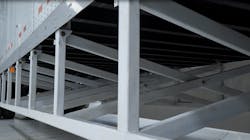The case for mandating and maintaining underride guards
Few things are more terrifying than an underride vehicle accident, a type of crash involving a car, motorcycle, or other vehicle sliding under a semi-truck trailer. When this occurs, the vehicle’s roof is often peeled back and its cabin crushed as it skids beneath the truck’s trailer. Unfortunately, catastrophic head trauma, brain injury, and death often result from these accidents.
How underride accidents occur
Tractor-trailers are massive machines. Because commercial trucks ride higher off the road, the occupants of passenger vehicles are more at risk than commercial truck drivers when they collide. Upon collision, the height and weight disparity between huge trucks and cars can lead to serious structural damage.
In the event of a collision, the front of a car is built to take the brunt of the force and keep its passengers safe. However, if the smaller vehicle slides beneath the trailer in an underride crash, its safety features and mechanisms are essentially rendered useless. Instead, the car’s passenger compartment sustains the most damage, with the occupants taking the brunt of the force.
See also: Side underride notice triggers cost-benefit debate
The problem created by inadequate underride guards
When smaller vehicles collide with the back of high-riding tractor-trailers, strong metal bars called underride guards are designed to prevent the cars from slipping under the truck and being crushed. Without this sturdy underride guard as a barrier, a passenger car that collides with a semi-truck is more likely to be crushed underneath the trailer.
For this reason, truck drivers must inspect their rear and side underride guards to ensure they are working as intended. A quick visual inspection can ensure that the guards are clear of corrosion and ascertain whether or not the side guards are installed correctly.
Due to faulty construction or lackluster maintenance, the underride protection on the rear or sides of some commercial and 18-wheel semi-trucks could be deemed inadequate or not sturdy enough to survive a collision. When these guards are corroded, improperly secured, or broken, they may shatter or disintegrate upon impact, thereby increasing the risk of serious harm to other drivers.
Injuries sustained in an underride crash, if the truck’s underride guards are not operating in accordance with the law, are the legal responsibility of the company or organization that owns the truck. Additionally, truck drivers themselves can be issued fines for failing to properly install or maintain guards on their vehicles, but many can simply pay the minimal fine and have their trucks remain on the road — despite the risk they pose to other drivers.
Legislation regarding underride guards on commercial trucks
Most semi-trucks are now required by law to have underride guards installed on the back of the trailer, which help block cars from driving underneath the truck in the case of a rear-end collision. But side underride guards, though similar to rear underride guards, are not mandated by current federal legislation for vehicles. Government figures reveal that side impact underride incidents involving truck trailers are responsible for over 200 deaths every year, as reported by NBC News.
In December 2017, Congress considered a bill that would have mandated underride protections on the sides of truck trailers and on the front of commercial trucks. If this bill had passed, it would have required trailers, semi-trailers, and single-unit trucks above 10,000 lbs. manufactured on or after the rule's implementation date to be equipped with side underride protections. Commercial vehicles over 10,000 lbs. constructed on or after the rule's effective date would also have been required to have front underride protections installed.
While the bill did not initially receive strong support, many still believe that current legislation does not go far enough and argue for regulations requiring the installation of side guards and stronger rear underride guards. In Canada, for instance, commercial trucks must deploy underride protection devices that are 1.75 times sturdier and absorb about four times more energy than those in the U.S.
See also: IIHS criticizes NHTSA underride guard study
Challenges to legislation mandating side guards on commercial trucks
Trucking companies contend that required side impact guards will drive up the price of trucks, make them heavier, and become ineffective in safety evaluations. Conversely, advocates for vehicle safety say the modifications present a small price to pay for the lives these guards will save. The National Highway Traffic Safety Administration conducted a cost-benefit analysis of mandating side underride guards, estimating that equipping U.S. tractor-trailer trucks will cost between $973 million and $1.2 billion.
Currently, the greatest challenge to the widespread adoption of side guards across the trucking industry is the cost of retrofitting the immense fleet of trailers already on our roads, though a gradual phasing of these requirements would help to alleviate the challenges. There are also logistical and supply issues that would need to be addressed, as tractor-trailers are required to undergo regular maintenance inspections. Still, a reasonable phase-in of these guards could be made possible on that schedule.
This issue is too important to remain unaddressed. Policymakers must be willing to stand up to the industry and require trailers to have side guards on public roads or incentivize the installation of these guards by trucking companies.
Of course, we must consider the economic impact on our transportation industry, but doing nothing to further this life-saving safety enhancement due to industry pushback is unacceptable.
About the Author

George Salinas
George Salinas is an award-winning lawyer and the founder of George Salinas Injury Lawyers. His legal specialties include: Motor vehicle and work accidents, personal injury, drunk driving, and more. Before founding his law firm, Salinas graduated from the University of Texas School of Law, working for Judge Fred Biery (Federal District Court of the Western District of Texas) and Chief Justice Alma Lopez (Fourth Court of Appeals of Texas). After two private firm clerkships and another with the Texas Attorney General’s Office, Salinas served as a policy analyst in the Texas Senate during the 79th Legislature. He then defended corporations and insurance companies in personal injury cases but knew his underlying passion was for representing people in need. He began representing victims and their families in serious personal injury and wrongful death cases, handling hundreds of cases against insurance companies and corporations throughout Texas. To this day, he's a proud advocate and resource for people seeking justice. Salinas believes the right to trial by jury is a fundamental part of our country’s foundation and has found his calling empowering victims of personal injury and wrongful death to exercise that right.
